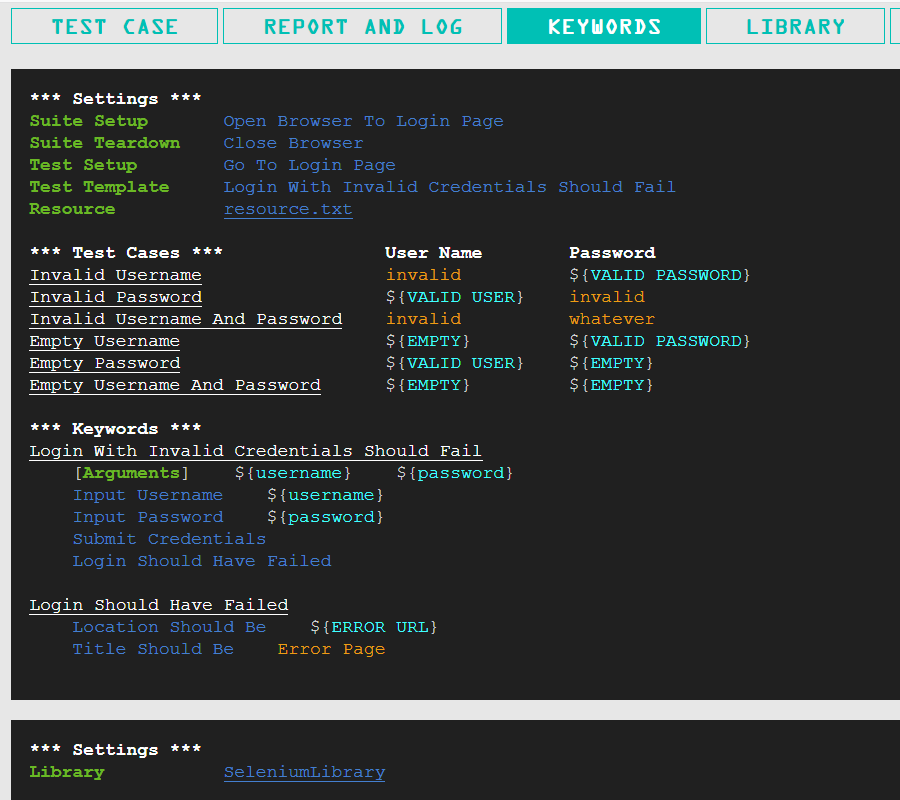
Transcripted Summary
Let's talk a little bit about the settings section.
I'm going to go into my tour-of directory and open up tour-of.robot because it's got an example of a nice big setting section.
# Example Code - tour-of.robot
*** Settings ***
Library SeleniumLibrary
Library OperatingSystem
Library Collections
Resource resources.robot
Resource invoice-details-page.robot
Resource navigation.robot
Resource system.robot
Resource data.robot
Suite Setup Run Keywords Initialize Test Data Configure Selenium Navigate To Homepage
Suite Teardown Exit Selenium
*** Test Cases ***
Create An Invoice
${invoice}= Get Dummy Invoice demo
Navigate To Add Invoice
Fill Out Invoice Details ${invoice}
Submit Invoice Form
${invoice_id}= Get Invoice Id ${invoice}
Page Should Contain ${invoice_id}
Open Invoice ${invoice_id}
# Settings - Library
We've already talked about the Library keyword and how we can use preexisting libraries full of keywords in our test cases. The Library keyword can pull in preexisting ones.
Your developers can make libraries for Robot Framework. You could even pull in a Python package and use it here.
Any publicly exposed method or function within Python can be exposed as a keyword by pulling it in with the Library keyword here.
# Settings - Resource
Resources, these are the files that you build. You may have files that have Keywords in them. You may have some that have Variables in them.
There are lots of different ways to use the Resource keyword but it helps you keep your keywords in certain groups.
For instance, in this case, we've grouped together all the navigation keywords into a file called navigation.robot.
*** Keywords ***
Navigate To Add Invoice
Click Element css:[href="#/addInvoice"]
Open Invoice
[Arguments] ${id}
Click Link css:#invoiceNo_${id} > a
We've got basically a Page Object in our invoice-details-page.robot.
*** Keywords ***
Enter Invoice Number
[Arguments] ${invoice_id}
Input Text css:[ng-model="invoice.invoiceNo"] ${invoice_id}
Enter Company Name
[Arguments] ${company_name}
Input Text css:[ng-model="invoice.companyName"] ${company_name}
Enter Type of Work
[Arguments] ${type_of_work}
Input Text css:[ng-model="invoice.typeOfWork"] ${type_of_work}
Enter Amount
[Arguments] ${amount}
Input Text css:[ng-model="invoice.price"] ${amount}
Select Status
[Arguments] ${status}
Select From List By Value css:[ng-model="invoice.status"] ${status}
Enter Due Date
[Arguments] ${due_date}
Input Text css:[ng-model="invoice.dueDate"] ${due_date}
Enter Description
[Arguments] ${description}
Input Text css:[ng-model="invoice.comment"] ${description}
Submit Invoice Form
Click Button createButton
Fill Out Invoice Details
[Arguments] ${invoice}
Enter Invoice Number ${invoice["id"]}
Enter Company Name ${invoice["company_name"]}
Enter Type of Work ${invoice["type_of_work"]}
Select Status ${invoice["status"]}
Enter Amount ${invoice["amount"]}
Enter Due Date ${invoice["due_date"]}
Enter Description ${invoice["description"]}
We've got system keywords in system.robot.
*** Keywords ***
Configure Selenium
Set Selenium Speed .25 Seconds
Navigate To Homepage
Open Browser ${SiteUrl} ${BROWSER}
Maximize Browser Window
Exit Selenium
Capture Page Screenshot
Close Browser
Generate Random Number
${random_number} Evaluate random.randint(1000000, 9999999) random
[return] ${random_number}
And we've got our data that we use in data.robot.
*** Keywords ***
Read Invoice Fixtures
${json_data}= Get File ${EXECDIR}/invoice-fixtures.json
${json}= evaluate json.loads('''${json_data}''') json
[return] ${json}
Initialize Test Data
${json}= Read Invoice Fixtures
set global variable ${Invoices} ${json}
Get Dummy Invoice
[Arguments] ${invoice_name}
${invoice}= Get From Dictionary ${Invoices} ${invoice_name}
Randomize Invoice Id ${invoice}
[return] ${invoice}
Randomize Invoice Id
[Arguments] ${invoice}
${random_number}= Generate Random Number
Update Invoice Id ${invoice} ${random_number}
Update Invoice Id
[Arguments] ${invoice} ${id}
set to dictionary ${invoice} id=${id}
Get Invoice Id
[Arguments] ${invoice}
${invoice_id}= Convert To String ${invoice["id"]}
[return] ${invoice_id}
There are a lot of other cool things you can do in the Setting section.
Make sure to look at robotframework.org and the documentation there to learn more about different keywords you can use in the Settings section.

Some of my favorites are Suite Setup, Suite Teardown, Test Setup and Test Teardown.
The Suite Setup allows you to run specific keywords prior to this entire suite running.
Suite Setup Run Keywords Initialize Test Data Configure Selenium Navigate To Homepage
Here, I've got a keyword called Run Keywords allowing me to run more than one keyword at a time.
Then Initialize Test Data, which is one of my custom keywords in one of the resource files. Configure Selenium is another one of these that I've created, and Navigate To Homepage.
We run those in order from left to right prior to this suite or this file running.
So, before any test cases, we do those 3 steps. After all the test cases are done, we do Exit Selenium using this Suite Teardown.
This is a little bit different in terms of how control flow works within Robot Framework.
We previously said that control flow works by executing the test case with the Variable section first, the Settings section second, the Test Cases third. This breaks that rhythm. It breaks that paradigm.
Suite Setupgets run prior to the test cases.Suite Teardownruns after all test cases.
But both of those keywords are in the Settings section.
I know that's a little confusing. Take a look at the documentation for different explanations that might work better for you.
The Settings section is basically something you can think of as your configuration, your steps before the test case, your preconditions.
